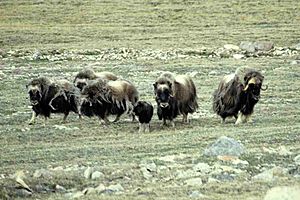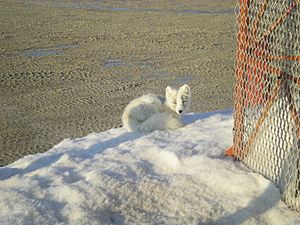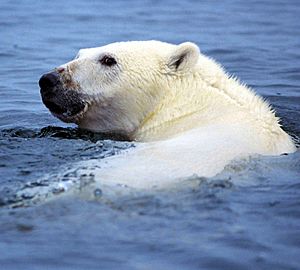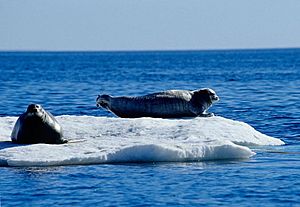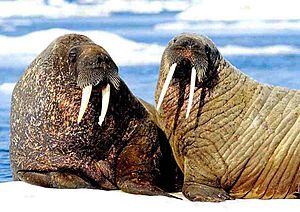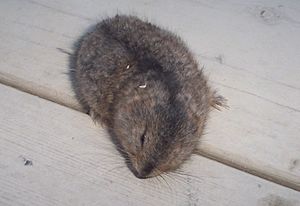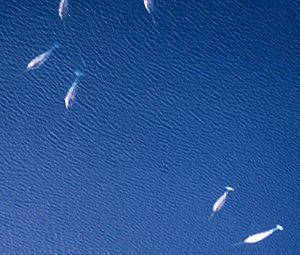List of mammals of Nunavut facts for kids
Nunavut is a huge, cold land in northern Canada, and it's home to many amazing animals called mammals (ᐱᓱᒃᑎ, pisukti). For the Inuit people who have lived there for thousands of years, these animals were super important. They used almost every part of them! For example, big animals like the Caribou provided food, their skins were used for warm clothes and tents, and their strong sinews became thread for sewing. Even smaller animals like the Arctic fox could be eaten during tough times. Later, fox furs became valuable for trading, but traditionally, their skins were not often used, except for specific purposes. The skins of tiny animals, like the Least weasel, were sometimes used to decorate clothing.
Some animals, like the Canada lynx, are very shy and live mostly in the southern parts of Nunavut, far from towns. So, you might not see them often!
The Inuit people speak different kinds of Inuktitut and Inuinnaqtun languages. Because of this, the names and spellings for animals can be different from one area to another.
Contents
Hoofed Mammals (Artiodactyla)
These mammals are known for having hooves, which are like hard toenails that protect their feet. They are often plant-eaters.
Muskoxen and Caribou
- Muskox (ᐅᒥᖕᒪᒃ, umingmak) Ovibos moschatus
* Muskoxen are big, shaggy animals that look a bit like small bison. They have very thick fur to stay warm in the Arctic cold.
- Caribou (ᑐᒃᑐ, tuktut) Rangifer tarandus
* Caribou are a type of deer. They are famous for their long migrations, traveling huge distances to find food. * Barren-ground caribou (ᓇᐹᕐᑐᕐᑲᓐᖏᑦᑐᒥ ᑐᒃᑐ, tuktut) Rangifer tarandus groenlandicus * These caribou live in the open, treeless areas of Nunavut. * Peary caribou (ᕐᑯᑦᓯᑦᑐᒥ ᑐᒃᑐ, tuku) Rangifer tarandus pearyi * Peary caribou are smaller and lighter in color. They live on the Arctic islands.
- Moose Alces alces
* Moose are the largest members of the deer family, known for their huge antlers. * Western moose (ᑐᒃᑐᕙᒃ, tuktuvak) Alces alces andersoni * These moose are found in the more forested southern parts of Nunavut.
Meat-Eating Mammals (Carnivora)
This group includes animals that mostly eat meat. They have sharp teeth and claws to hunt their prey.
Wolves and Foxes
- Grey wolf (ᐊᒪᕈᖅ, amaruq) Canis lupus
* Wolves are smart hunters that often live and hunt in packs. * Arctic wolf Canis lupus arctos * This type of wolf lives in the far north and has a thick white coat.
- Arctic fox (ᑎᕆᒐᓐᓂᐊᖅ, tiriganniak) Vulpes lagopus
* Arctic foxes are small and clever. Their fur changes color with the seasons, from white in winter to brown or grey in summer, helping them blend in.
- Red fox (ᑲᔪᖅ, kajuqtuq) Vulpes vulpes
* Red foxes are common and can be found in many different habitats.
Wild Cats and Bears
- Canada lynx (ᐱᖅᑐᖅᓯᕋᖅ, piqtuqsiraq) Lynx canadensis
* Lynx are wild cats with tufted ears and big paws, which help them walk on snow.
- Black bear (ᐊᒃᖤᒃ, aklaq) Ursus americanus
* Black bears are usually found in forested areas.
- Grizzly bear (ᓇᐹᖅᑐᖃᖕᒋᑦᑐᒥ ᐊᒃᖤᒃ, atiqpuq) Ursus arctos horribilis
* Grizzly bears are large and powerful, known for the hump on their shoulders.
- Polar bear (ᓇᓄᖅ, nanuq) Ursus maritimus
* Polar bears are iconic Arctic animals, perfectly adapted to life on ice and snow. They are excellent swimmers and hunt seals.
Weasels and Otters
- Wolverine (ᖃᕝᕕᒃ, qalvik) Gulo gulo
* Wolverines are strong and fierce animals, known for their toughness.
- River otter (ᑯᒻᒥ ᐸᒥᐅᖅᑑᖅ, pamiuqtuuq) Lontra canadensis
* River otters are playful and love to swim in rivers and lakes.
- Beringian ermine (ᑎᕆᐊᖅ, tiriaqpak) Mustela erminea
- American ermine (ᑎᕆᐊᖅ, tiriaqpak) Mustela richardsonii
- Least weasel (ᒥᑭᓂᖅᓴᖅ ᑎᕆᐊᖅ, tiriaq) Mustela nivalis
* Ermines and weasels are small, quick hunters. Their fur often turns white in winter.
- American marten (ᖃᑉᕕᐊᕐᓯᐊᖅ, qapviarsiaq) Martes americana
- American mink (ᑎᕆᐊᖅᐸᒃ, tiriaqpak) Neogale vison
- Fisher (ᑎᕆᐊᕐᔪᐊᖅ) Pekania pennanti
Seals and Walruses
These marine mammals spend most of their lives in the ocean.
- Bearded seal (ᐅᒡᔪᒃ, ugjuk) Erignathus barbatus
* Bearded seals are large seals with long whiskers that look like a beard.
- Hooded seal (ᓇᑦᓯᕙᒃ, natsivak) Cystophora cristata
- Harbour seal (ᖃᓯᒋᐊᖅ, qasigiaq) Phoca vitulina
- Harp seal (ᖃᐃᕈᓕᒃ, qairulik) Pagophilus groenlandicus
- Grey seal (ᐳᕕᓲᖅ, puvisuuq) Halichoerus grypus
- Ringed seal (ᓇᑦᑎᖅ, nattiq) Pusa hispida
* Ringed seals are the most common seals in the Arctic and are a main food source for polar bears.
- Walrus (ᐊᐃᕕᖅ, aiviq) Odobenus rosmarus
* Walruses are huge marine mammals with long tusks. They use their tusks to pull themselves onto ice and to dig for food on the seabed.
Hares (Lagomorpha)
This group includes rabbits and hares. They have long ears and powerful hind legs for hopping.
- Arctic hare (ᐅᑭᐅᖅᑕᖅᑐᒥ ᐅᑲᓕᖅᐸᒃ, ukaliq) Lepus arcticus
* Arctic hares are well-adapted to the cold, with thick fur and a white coat in winter.
- Snowshoe hare (ᑭᖑᓪᓖᕐᑯᕐᑐᔪᖅ ᐅᑲᓕᖅ) Lepus americanus
* Snowshoe hares have large feet that act like snowshoes, helping them move easily over snow.
Rodents (Rodentia)
Rodents are known for their continuously growing front teeth, which they keep short by gnawing.
- American beaver (ᑭᒋᐊᖅ, kigiaq) Castor canadensis
* Beavers are famous for building dams and lodges in rivers.
- Muskrat (ᐊᕕᙵᕐᔪᐊᖅ, kivgaluk) Ondatra zibethicus
* Muskrats are semi-aquatic rodents that look like small beavers.
- North American brown lemming (ᑲᔪᖅ ᐊᕕᙵᖅ, avin'ngaq) Lemmus trimucronatus
- Peary land collared lemming (ᕐᑲᑯᖅᑕᖅ ᐊᕕᙵᖅ, avin'ngaq) Dicrostonyx groenlandicus
* Lemmings are small, furry rodents that live in the Arctic tundra. Their populations can change a lot from year to year.
- Meadow vole (ᐊᕕᙵᕋᓛᖅ) Microtus pennsylvanicus
- Northern red-backed vole (ᐅᑭᐅᖅᑕᖅᑐᒥ ᐊᐅᐸᖅᑐᒥᒃ ᕐᑯᓖᓕᒃ ᐊᕕᙵᕋᓛᖅ) Myodes rutilus
- Brown rat (ulimakka) Rattus norvegicus
* Brown rats are not native to Nunavut; they were introduced by humans.
- Arctic ground squirrel (ᓯᒃᓯᒃ, siksik) Spermophilus parryii
* Arctic ground squirrels are burrowing rodents that hibernate for long periods.
- Red squirrel (ᐊᐅᐸᖅᑐᖅ ᓯᒃᓯᐅᔭᖅ) Tamiasciurus hudsonicus
Shrews (Insectivora)
Shrews are tiny, mouse-like mammals with long snouts, known for eating insects.
- Masked shrew (ᐊᐅᐸᖅᑐᖅ ᓯᒃᓯᐅᔭᖅ, uqjunqnaq) Sorex cinereus
* Masked shrews are some of the smallest mammals in Nunavut.
Bats (Chiroptera)
Bats are the only mammals that can truly fly. They use echolocation to navigate and find food in the dark.
- Hoary bat (ᕐᑭᖑᔭᖅ ᑎᒻᒥᓲᖅ ᐊᕕᙵᐅᔭᖅ) Lasiurus cinereus
- Little brown myotis (ᒥᑭᔪᖅ ᑲᔪᖅ ᑎᒻᒥᓲᖅ ᐊᕕᙵᐅᔭᖅ) Myotis lucifugus
* These bats are usually found in the southern parts of Nunavut.
Whales and Dolphins (Cetacea)
This group includes all whales, dolphins, and porpoises, which are marine mammals that live entirely in the water.
Baleen Whales
These whales have baleen plates in their mouths instead of teeth, which they use to filter small organisms from the water.
- Bowhead whale (ᐊᕐᕕᖅ, arviq) Balaena mysticetus
* Bowhead whales are huge and can live for a very long time, sometimes over 200 years!
- Fin whale Balaenoptera physalus
- Sei whale Balaenoptera borealis
- Blue whale (ᐊᕐᕕᖅ ᓂᐊᖁᕐᓗᖕᓂᖅᓴᖅ, ipak) Balaenoptera musculus
* Blue whales are the largest animals on Earth.
- Common minke whale Balaenoptera acutorostrata
- Humpback whale Megaptera novaeangliae
* Humpback whales are known for their beautiful songs and acrobatic breaches.
Toothed Whales and Dolphins
These whales have teeth and hunt larger prey like fish and squid.
- Killer whale (ᐋᕐᓗ, aarlu) Orcinus orca
* Killer whales, also known as orcas, are powerful predators and the largest dolphins.
- Narwhal (ᑑᒑᓕᒃ, tuugaalik) Monodon monoceros
* Narwhals are often called the "unicorns of the sea" because the males have a long, spiraled tusk that can grow up to 10 feet long!
- Beluga whale (ᕿᓇᓗᒐᖅ, qilalugaq) Delphinapterus leucas
* Beluga whales are white and very vocal, often called "sea canaries" because of the sounds they make. * Cumberland Sound beluga
- Harbour porpoise Phocoena phocoena
- Sperm whale (ᑭᒍᑎᓕᒃ, kigutilik) Physeter macrocephalus
* Sperm whales are the largest toothed whales and can dive very deep.
- Northern bottlenose whale Hyperoodon ampullatus
See also


